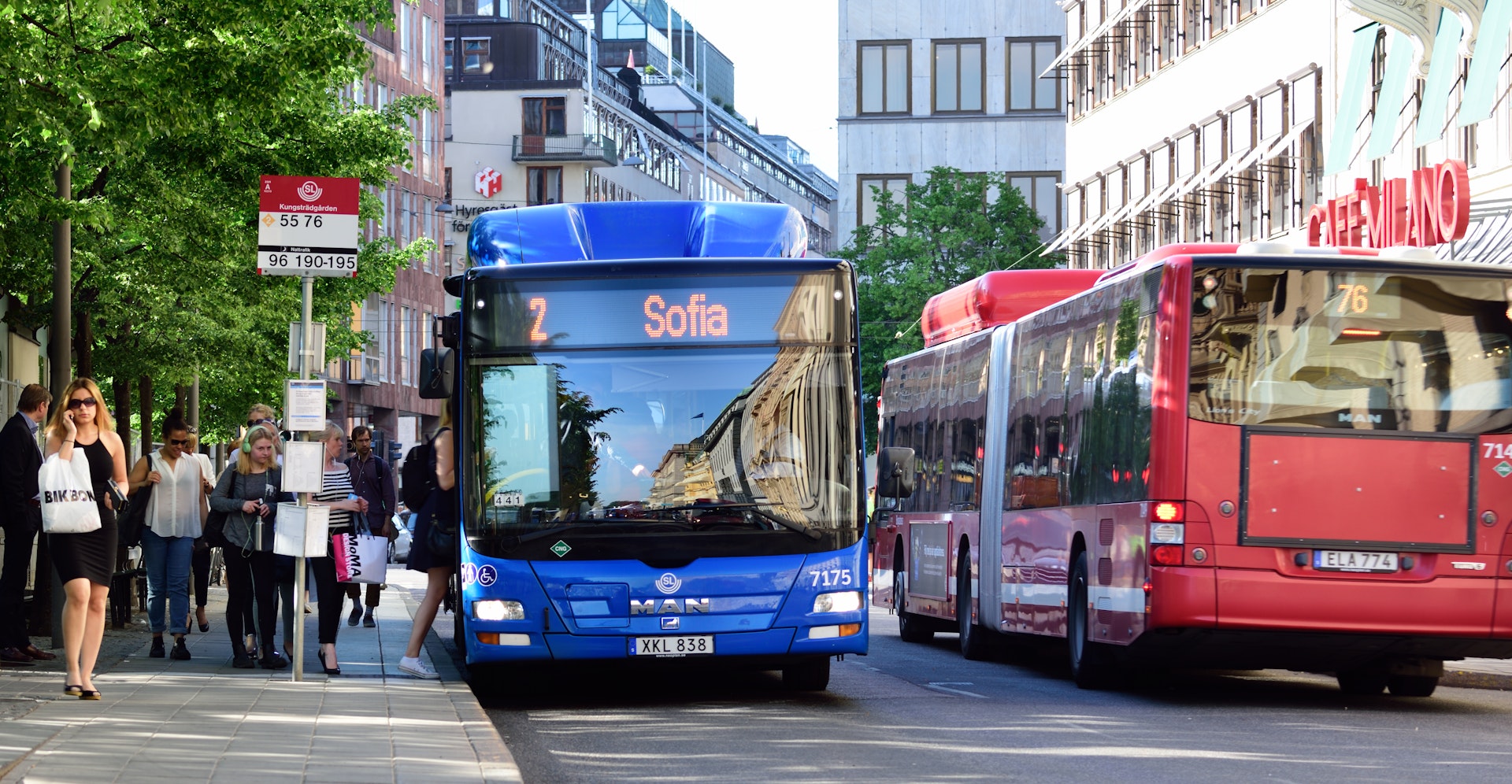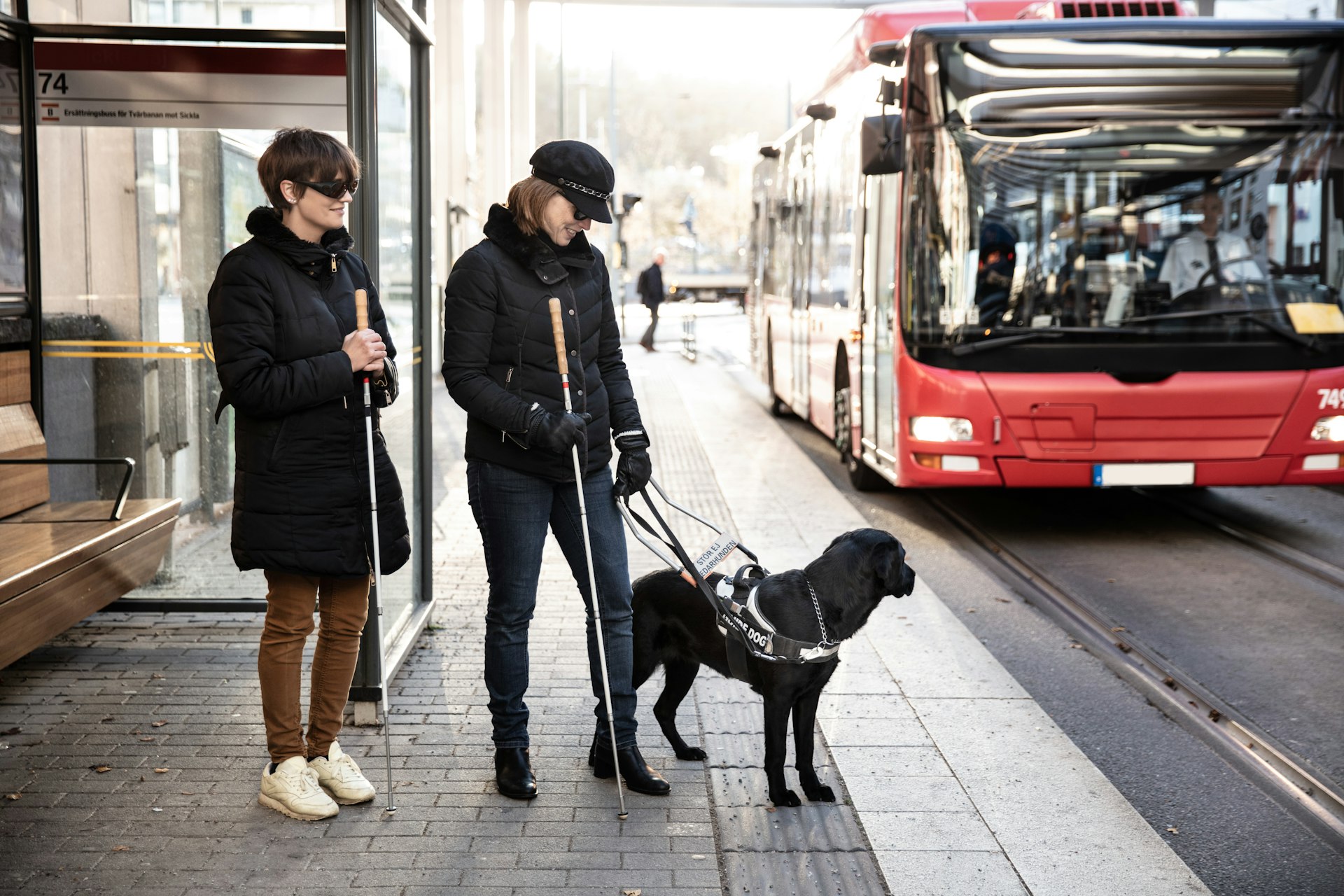Compared to many European capitals, getting around Stockholm is a breeze. Its compact size makes it a dream for visitors who are keen to walk or cycle between sights. Public transportation is reliable, intuitive, and clean.
Bus services run round-the-clock in the city center, while trains and ferries can help you get further afield. There’s also been a strong focus on accessibility for decades, designed to help those with visual and mobile impairments as well as parents with young children.

Subway
Known as the tunnelbana or t-bana to locals, Stockholm’s efficient underground network includes more than 100 stations. It runs between 5am and 1am on weekdays, with trains at least every 10 minutes at peak times of the day. Reduced services operate round-the-clock on Friday and Saturday nights. There are three color-coded lines (green, blue, and red).
These split into different branches once you leave the city center, so be careful to check that the end destination on the front of the train tallies with your direction of travel. The underground (alongside buses, trams, trains, and ferries) is part of Stockholm’s unified public transport network, known as SL, which has an excellent journey planner on its website or via its app.

Train
Stockholm’s commuter train network has been strengthened in recent years, with slick new stations built at major transport hub Stockholm City (which is connected to Stockholm Central station, also known as T-Centralen), and Odenplan, slightly further north. These trains are a quick and comfortable way to traverse the capital and a handy option for day trips outside the city center.

Bus
Bus services supplement trains, trams, and subway lines in the city center, operating round-the-clock when the rest of the network has shut down for the night. They have a strong reputation for running to timetable, with any delays usually visible in the SL public transport planning app. And they aren’t just a way to get around urban areas – services regularly reach some of the most remote villages and islands within Stockholm’s borders.

Tram
There are several tram lines connecting Stockholm’s outer suburbs, but for visitors, the most popular route is Line 7. This serves Djurgården island, where many of Stockholm’s most popular museums are based. You can board it from two stops in the city center, Hamngatan or Nybrokajan, both of which are just a short walk from Kungsträdgården or Östermalmstorg subway stops.

Ferry
Ferries are intertwined with Stockholm’s waterfront identity and for decades commuters lucky enough to live on the city’s coastline have been using them to get to work. SL network cards are valid on all commuter services to and from the city center, including the popular shuttle between Slussen and Djurgården (route 82) which takes just a few minutes.
Waxholmsbolaget ferries run deeper into the archipelago – you can buy tickets onboard or use the SL app or an SL Access Card to pay (more information below). Note that single Waxholmsbolaget journeys are significantly pricer than normal SL single journeys, costing between 56 and 169 SEK for adults or between 38 and 112 kronor for over-65s, under 20s, and students.
A local’s tips for using the SL public transport network
A single journey ticket for the Stockholm subway, as well as buses, trams, commuter trains and short-distance SL ferries costs 38 SEK for adults, or 25 SEK for those under 20 or over 65, and registered older students. It’s valid for 75 minutes and includes as many station or line changes as you need during that period. You can also switch to any other forms of transportation within the SL network during your trip.
If you’re likely to be making more than a couple of journeys a day, you’re usually better off choosing a travelcard valid for 24 hours, 72 hours, or 7 days.

Given the Swedish capital’s reputation as a tech-savvy, digitally-minded city, there are multiple ways to pay. But beware, you always need to purchase a ticket in advance of boarding.
Digital single tickets and travel cards can be bought using the free journey planner mobile app SL, which you then use to tap in at any one of SL’s readers upon entry to a station. Alternatively, you can buy a plastic SL Access card, on which you load prepaid credit or a travel pass. These are available at subway stations or Pressbyrån and 7-11 convenience stores.
For single-journeys you can also tap in using physical contactless bank cards connected to major card networks (Mastercard, Visa or American Express), or digital wallets such as Samsung Pay, Google Pay, Apple Pay and Fidesmo Pay. But note that discounted fares for students and seniors aren’t available using these methods.

Cycle
Stockholm is prepped for cyclists, with more than 100km of largely well-maintained bike lanes, including many that are gritted during colder months. The city council has put together a route map and a map of free pump locations.
Unfortunately renting a bike is trickier than it used to be, after a long-running city-wide bike-sharing system was stopped in 2019. However there are still decent rental spots including Rent-a-Bike in Östermalm and the similarly-named RentBike, which has a collection point on Kungsholmen. In the Old Town, try Gamla Stans Cykel.

E-scooter
There’s been a boom in app-based electric scooter companies operating in Stockholm over the past couple of years. It’s divided locals, with some embracing them as an innovative, convenient way of exploring the city, and others raising concerns about safety following an increase in accidents, especially in the evenings. Voi, Lime and Tier are the major competitors.

Taxi
Taxis are pricey in Stockholm, but can be a good option for larger groups. The major operators are Taxi Stockholm and Sverige Taxi, which you can hail in the city centre, or book by phone, online or using the firms’ apps.
Beware of rogue operators with similar branding at major ranks such as Arlanda Airport and Stockholm Central Station. Uber is licenced to operate in Stockholm, alongside European competitor Bolt.

Car
Stockholm’s impeccable public transport system means you’re unlikely to need to rent a car during shorter stays, and finding parking can be tricky. But if you’re planning multiple-day tours or overnight trips in the region, most major European operators service the Swedish capital including Avis, Europcar and Hertz. Snapcar is a cheaper option, where you rent cars directly from owners in your neighborhood. You need to be 18 years old to rent a vehicle in Sweden, and to have held a licence for a minimum of two years.

Walking
City planners have long worked to ensure the Swedish capital is a walkable destination, with wide sidewalks, well-lit footpaths and thoroughfares in parks and residential neighborhoods, and strong marking and signposting when it comes to coastal or woodland trails. Many of Stockholm’s most popular tourist spots are within a 30-minute walk from one another.
If you don’t have a smartphone, free fold-out maps are available from city tourist information offices. When heading to nature spots outside the centre, you might want to enlist the help of a hiking app like Naturkartan or AllTrails.

Accessible transportation in Stockholm
Stockholm set a goal to become Europe’s most accessible city back in 1998, and it has made great improvements for those with visibility or mobility challenges, as well as parents traveling with small children.
There are lifts at every subway and train station on the SL public transport network. Subway trains and platforms are at the same level at nearly all stops, although some commuter trains require ramps. All city center buses have automatic ramps. Travel is free for one adult accompanying a child in a stroller. Stop names and journey progress is usually displayed on a digital screen, and via an audio system. SL also offers free phone advice on accessibility, as well as bookable guiding assistance.
Most major attractions are well-designed for wheelchairs, including ABBA The Museum, The Royal Palace, Fotografiska and Skansen. For a full list head to the Stockholm Museums website. The Association of Qualified Tourist Guides offers tours from locals fluent in sign language, and is specifically designed for small children.
Ramps suitable for wheelchairs and strollers are common at public staircases around the city centre, especially in locations close to public transport. Other initiatives include improved water access for wheelchair users at city beaches including Ångebybadet, Sätrabadet and Tanto strandbad.
You may also like:
Top 10 free things to do in Stockholm
Guide to Stockholm Pride












